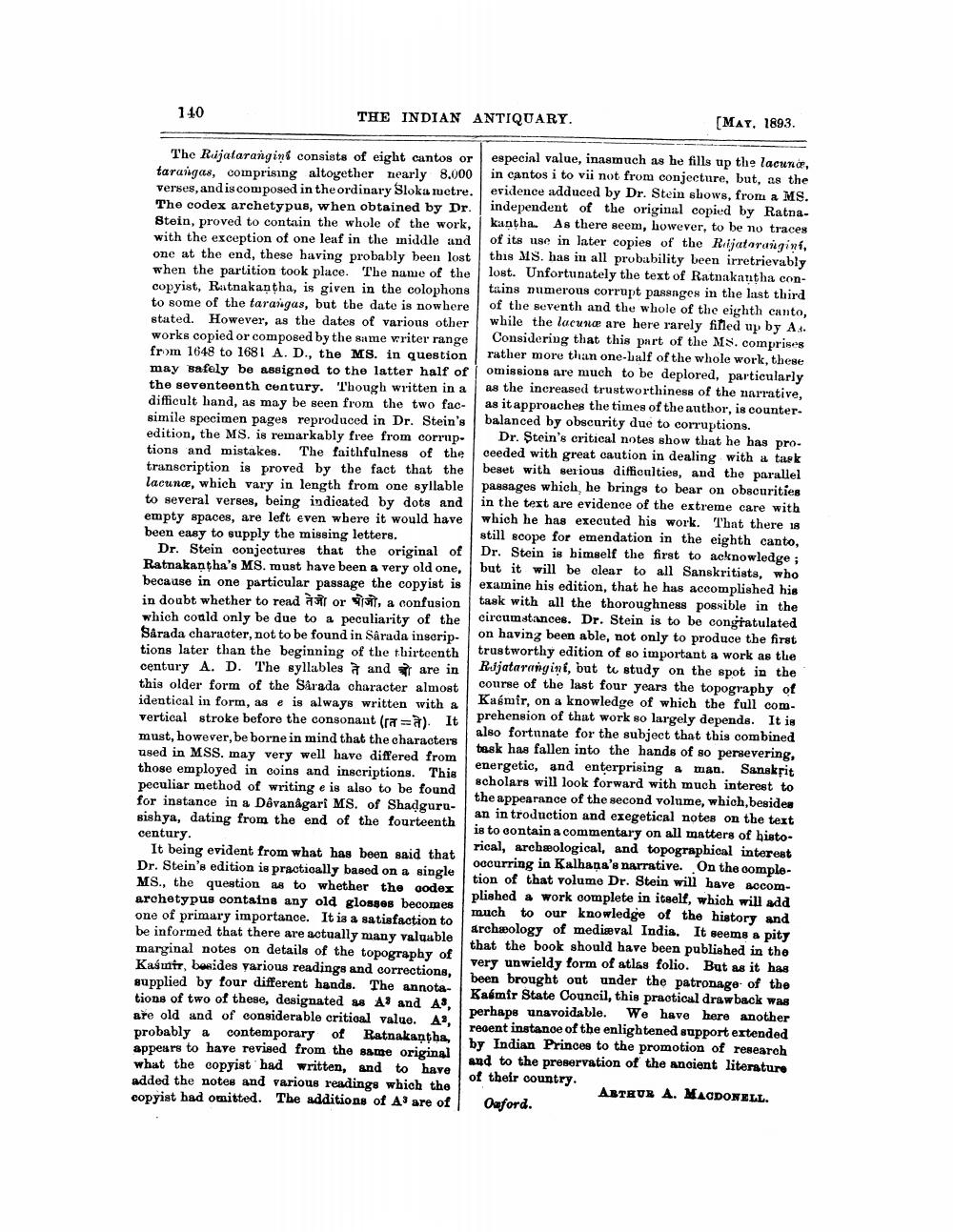________________
140
THE INDIAN ANTIQUARY.
The Rujalarangins consists of eight cantos or tarangas, comprising altogether nearly 8.000 verses, and is composed in the ordinary Sloka metre. The codex archetypus, when obtained by Dr. Stein, proved to contain the whole of the work, with the exception of one leaf in the middle and one at the end, these having probably been lost when the partition took place. The name of the copyist, Ratnakantha, is given in the colophons to some of the tarangas, but the date is nowhere stated. However, as the dates of various other works copied or composed by the same writer range from 1648 to 1681 A. D., the MS. in question may safely be assigned to the latter half of the seventeenth century. Though written in a difficult hand, as may be seen from the two facsimile specimen pages reproduced in Dr. Stein's edition, the MS. is remarkably free from corrup tions and mistakes. The faithfulness of the transcription is proved by the fact that the lacunæ, which vary in length from one syllable to several verses, being indicated by dots and empty spaces, are left even where it would have been easy to supply the missing letters.
Dr. Stein conjectures that the original of Ratnakantha's MS. must have been a very old one, because in one particular passage the copyist is in doubt whether to read तेजो or भोजो, a confusion which could only be due to a peculiarity of the Sarada character, not to be found in Sârada inscriptions later than the beginning of the thirteenth century A. D. The syllables and are in this older form of the Sarada character almost identical in form, as e is always written with a vertical stroke before the consonant (ra). It must, however, be borne in mind that the characters used in MSS. may very well have differed from those employed in coins and inscriptions. This peculiar method of writing e is also to be found for instance in a Dêvanagari MS. of Shadgurusishya, dating from the end of the fourteenth century.
It being evident from what has been said that Dr. Stein's edition is practically based on a single MS., the question as to whether the codex archetypus contains any old glosses becomes one of primary importance. It is a satisfaction to be informed that there are actually many valuable marginal notes on details of the topography of Kasmir, besides various readings and corrections, supplied by four different hands. The annotations of two of these, designated as A3 and A3, are old and of considerable critical value. A3, probably a contemporary of Ratnakantha, appears to have revised from the same original what the copyist had written, and to have added the notes and various readings which the copyist had omitted. The additions of A3 are of
[MAY, 1893.
especial value, inasmuch as he fills up the lacunæ, in cantos i to vii not from conjecture, but, as the evidence adduced by Dr. Stein shows, from a MS. independent of the original copied by Ratnakantha. As there seem, however, to be no traces of its use in later copies of the Rijatarangini, this MS. has in all probability been irretrievably lost. Unfortunately the text of Ratnakantha contains numerous corrupt passages in the last third of the seventh and the whole of the eighth canto, while the lacunae are here rarely filled up by At. Considering that this part of the MS. comprises rather more than one-half of the whole work, these omissions are much to be deplored, particularly as the increased trustworthiness of the narrative, as it approaches the times of the author, is counterbalanced by obscurity due to corruptions.
Dr. Stein's critical notes show that he has proceeded with great caution in dealing with a task beset with serious difficulties, and the parallel passages which, he brings to bear on obscurities in the text are evidence of the extreme care with which he has executed his work. That there is still scope for emendation in the eighth canto, Dr. Stein is himself the first to acknowledge; but it will be clear to all Sanskritists, who examine his edition, that he has accomplished his task with all the thoroughness possible in the circumstances. Dr. Stein is to be congratulated on having been able, not only to produce the first trustworthy edition of so important a work as the Rajatarangini, but to study on the spot in the course of the last four years the topography of Kasmir, on a knowledge of which the full comprehension of that work so largely depends. It is also fortunate for the subject that this combined task has fallen into the hands of so persevering, energetic, and enterprising a man. Sanskrit scholars will look forward with much interest to the appearance of the second volume, which,besides an in troduction and exegetical notes on the text is to contain a commentary on all matters of historical, archeological, and topographical interest tion of that volume Dr. Stein will have accomoccurring in Kalhana's narrative. On the compleplished a work complete in itself, which will add much to our knowledge of the history and archeology of medieval India. It seems a pity that the book should have been published in the very unwieldy form of atlas folio. But as it has been brought out under the patronage of the Kasmir State Council, this practical drawback was recent instance of the enlightened support extended perhaps unavoidable. We have here another by Indian Princes to the promotion of research and to the preservation of the ancient literature
of their country.
ABTHUR A. MACDONELL.
Oxford.




